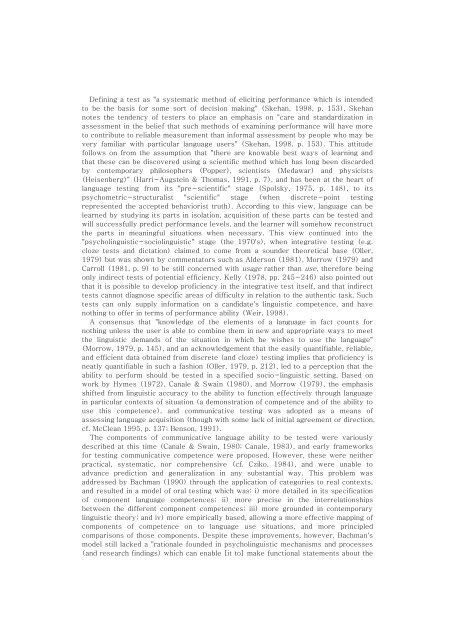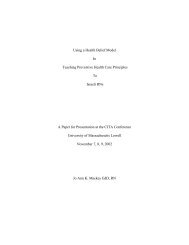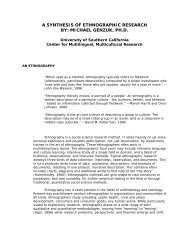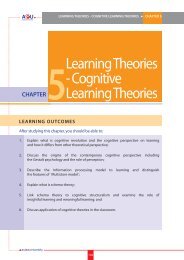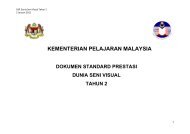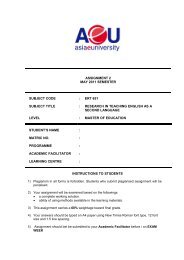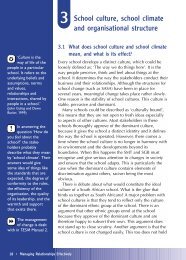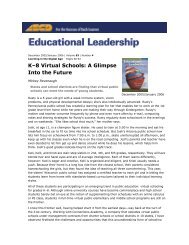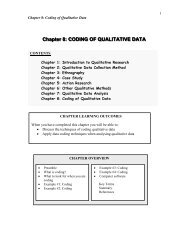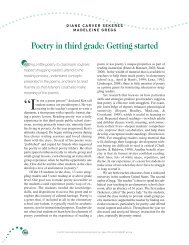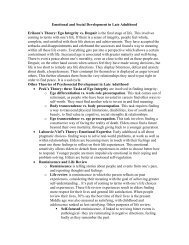Authentic Assessment : Implications for EFL Performance Testing in ...
Authentic Assessment : Implications for EFL Performance Testing in ...
Authentic Assessment : Implications for EFL Performance Testing in ...
You also want an ePaper? Increase the reach of your titles
YUMPU automatically turns print PDFs into web optimized ePapers that Google loves.
Def<strong>in</strong><strong>in</strong>g a test as "a systematic method of elicit<strong>in</strong>g per<strong>for</strong>mance which is <strong>in</strong>tendedto be the basis <strong>for</strong> some sort of decision mak<strong>in</strong>g" (Skehan, 1998, p. 153), Skehannotes the tendency of testers to place an emphasis on "care and standardization <strong>in</strong>assessment <strong>in</strong> the belief that such methods of exam<strong>in</strong><strong>in</strong>g per<strong>for</strong>mance will have moreto contribute to reliable measurement than <strong>in</strong><strong>for</strong>mal assessment by people who may bevery familiar with particular language users" (Skehan, 1998, p. 153). This attitudefollows on from the assumption that "there are knowable best ways of learn<strong>in</strong>g andthat these can be discovered us<strong>in</strong>g a scientific method which has long been discardedby contemporary philosophers (Popper), scientists (Medawar) and physicists(Heisenberg)" (Harri-Augste<strong>in</strong> & Thomas, 1991, p. 7), and has been at the heart oflanguage test<strong>in</strong>g from its "pre-scientific" stage (Spolsky, 1975, p. 148), to itspsychometric-structuralist "scientific" stage (when discrete-po<strong>in</strong>t test<strong>in</strong>grepresented the accepted behaviorist truth). Accord<strong>in</strong>g to this view, language can belearned by study<strong>in</strong>g its parts <strong>in</strong> isolation, acquisition of these parts can be tested andwill successfully predict per<strong>for</strong>mance levels, and the learner will somehow reconstructthe parts <strong>in</strong> mean<strong>in</strong>gful situations when necessary. This view cont<strong>in</strong>ued <strong>in</strong>to the"psychol<strong>in</strong>guistic-sociol<strong>in</strong>guistic" stage (the 1970's), when <strong>in</strong>tegrative test<strong>in</strong>g (e.g.cloze tests and dictation) claimed to come from a sounder theoretical base (Oller,1979) but was shown by commentators such as Alderson (1981), Morrow (1979) andCarroll (1981, p. 9) to be still concerned with usage rather than use, there<strong>for</strong>e be<strong>in</strong>gonly <strong>in</strong>direct tests of potential efficiency. Kelly (1978, pp. 245-246) also po<strong>in</strong>ted outthat it is possible to develop proficiency <strong>in</strong> the <strong>in</strong>tegrative test itself, and that <strong>in</strong>directtests cannot diagnose specific areas of difficulty <strong>in</strong> relation to the authentic task. Suchtests can only supply <strong>in</strong><strong>for</strong>mation on a candidate's l<strong>in</strong>guistic competence, and havenoth<strong>in</strong>g to offer <strong>in</strong> terms of per<strong>for</strong>mance ability (Weir, 1998).A consensus that "knowledge of the elements of a language <strong>in</strong> fact counts <strong>for</strong>noth<strong>in</strong>g unless the user is able to comb<strong>in</strong>e them <strong>in</strong> new and appropriate ways to meetthe l<strong>in</strong>guistic demands of the situation <strong>in</strong> which he wishes to use the language"(Morrow, 1979, p. 145), and an acknowledgement that the easily quantifiable, reliable,and efficient data obta<strong>in</strong>ed from discrete (and cloze) test<strong>in</strong>g implies that proficiency isneatly quantifiable <strong>in</strong> such a fashion (Oller, 1979, p. 212), led to a perception that theability to per<strong>for</strong>m should be tested <strong>in</strong> a specified socio-l<strong>in</strong>guistic sett<strong>in</strong>g. Based onwork by Hymes (1972), Canale & Swa<strong>in</strong> (1980), and Morrow (1979), the emphasisshifted from l<strong>in</strong>guistic accuracy to the ability to function effectively through language<strong>in</strong> particular contexts of situation (a demonstration of competence and of the ability touse this competence), and communicative test<strong>in</strong>g was adopted as a means ofassess<strong>in</strong>g language acquisition (though with some lack of <strong>in</strong>itial agreement or direction,cf. McClean 1995, p. 137; Benson, 1991).The components of communicative language ability to be tested were variouslydescribed at this time (Canale & Swa<strong>in</strong>, 1980; Canale, 1983), and early frameworks<strong>for</strong> test<strong>in</strong>g communicative competence were proposed. However, these were neitherpractical, systematic, nor comprehensive (cf. Cziko, 1984), and were unable toadvance prediction and generalization <strong>in</strong> any substantial way. This problem wasaddressed by Bachman (1990) through the application of categories to real contexts,and resulted <strong>in</strong> a model of oral test<strong>in</strong>g which was: i) more detailed <strong>in</strong> its specificationof component language competences; ii) more precise <strong>in</strong> the <strong>in</strong>terrelationshipsbetween the different component competences; iii) more grounded <strong>in</strong> contemporaryl<strong>in</strong>guistic theory; and iv) more empirically based, allow<strong>in</strong>g a more effective mapp<strong>in</strong>g ofcomponents of competence on to language use situations, and more pr<strong>in</strong>cipledcomparisons of those components. Despite these improvements, however, Bachman'smodel still lacked a "rationale founded <strong>in</strong> psychol<strong>in</strong>guistic mechanisms and processes(and research f<strong>in</strong>d<strong>in</strong>gs) which can enable [it to] make functional statements about the


